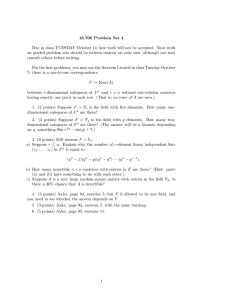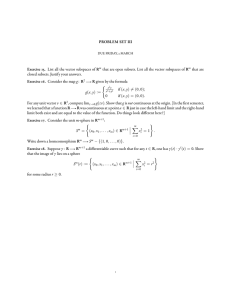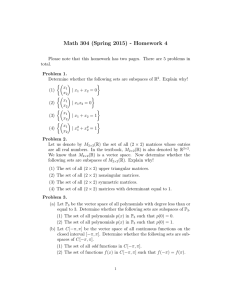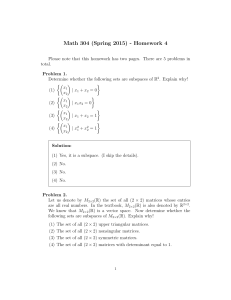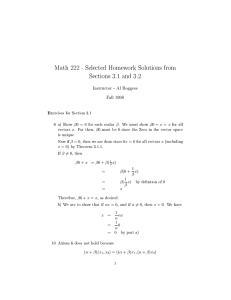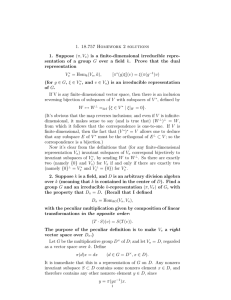T J N S
advertisement
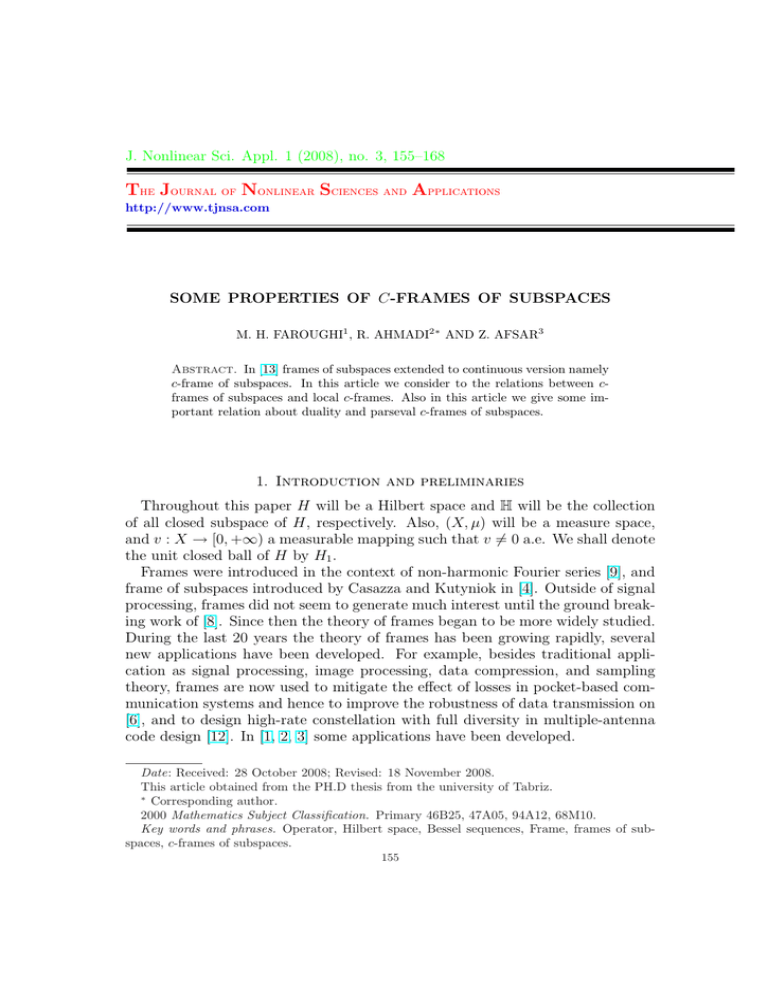
J. Nonlinear Sci. Appl. 1 (2008), no. 3, 155–168
The Journal of Nonlinear Sciences and Applications
http://www.tjnsa.com
SOME PROPERTIES OF C-FRAMES OF SUBSPACES
M. H. FAROUGHI1 , R. AHMADI2∗ AND Z. AFSAR3
Abstract. In [13] frames of subspaces extended to continuous version namely
c-frame of subspaces. In this article we consider to the relations between cframes of subspaces and local c-frames. Also in this article we give some important relation about duality and parseval c-frames of subspaces.
1. Introduction and preliminaries
Throughout this paper H will be a Hilbert space and H will be the collection
of all closed subspace of H, respectively. Also, (X, µ) will be a measure space,
and v : X → [0, +∞) a measurable mapping such that v 6= 0 a.e. We shall denote
the unit closed ball of H by H1 .
Frames were introduced in the context of non-harmonic Fourier series [9], and
frame of subspaces introduced by Casazza and Kutyniok in [4]. Outside of signal
processing, frames did not seem to generate much interest until the ground breaking work of [8]. Since then the theory of frames began to be more widely studied.
During the last 20 years the theory of frames has been growing rapidly, several
new applications have been developed. For example, besides traditional application as signal processing, image processing, data compression, and sampling
theory, frames are now used to mitigate the effect of losses in pocket-based communication systems and hence to improve the robustness of data transmission on
[6], and to design high-rate constellation with full diversity in multiple-antenna
code design [12]. In [1, 2, 3] some applications have been developed.
Date: Received: 28 October 2008; Revised: 18 November 2008.
This article obtained from the PH.D thesis from the university of Tabriz.
∗
Corresponding author.
2000 Mathematics Subject Classification. Primary 46B25, 47A05, 94A12, 68M10.
Key words and phrases. Operator, Hilbert space, Bessel sequences, Frame, frames of subspaces, c-frames of subspaces.
155
156
M. H. FAROUGHI, R. AHMADI, Z. AFSAR
The frames of subspaces were considered by Casazza and Kutyniok [12]. In
that paper they formulated a general method for piecing together local frames to
get global frames. The importance of that approach is that it is both necessary
and sufficient for the construction of global frames of local frames.
In this paper we try to obtain relations between c-frames of subspaces and local
c-frames. Also we get many useful relation about dual discussions.
Definition 1.1. Let {fi }i∈I be a sequence of members of H. We say that {fi }i∈I
is a frame for H if there exist 0 < A ≤ B < ∞ such that for all h ∈ H
X ­
®
| fi , h |2 ≤ Bkhk2 .
Akhk2 ≤
(1.1)
i∈I
The constants A and B are called frame bounds. If A, B can be chosen so that
A = B, we call this frame an A-tight frame and if A = B = 1 it is called a parseval
frame. If we only have the upper bound, we call {fi }i∈I a Bessel sequence. If
{fi }i∈I is a Bessel sequence then the following operators are bounded,
X
T : l2 (I) → H, T (ci ) =
ci fi
(1.2)
i∈I
­
®
T ∗ : H → l2 (I), T ∗ (f ) = { f, fi }i∈I
Sf = T T ∗ f =
X­
®
f, fi fi .
(1.3)
(1.4)
i∈I
This operators are called synthesis operator, analysis operator and frame operator, respectively.
Theorem 1.2. Let {fi }i∈I be a frame with frame operator S. Then
X­
®
h=
h, S −1 fi fi , ∀h ∈ H.
i∈I
The series converges unconditionally for all h ∈ H.
Proof. See [7] Theorem 5.1.6.
¤
In case {fi }i∈I is an overcomplete frame,Pby Theorem
­
® 5.6.1 in [7] there exist
−1
frames {gi }i∈I 6= {S fi }i∈I for which h = i∈I h, gi fi , for each h ∈ H. Such
frame is called dual frame of {fi }i∈I and {S −1 fi }i∈I is called canonical dual frame
of {fi }i∈I .
Lemma 1.3. Assume that {fi }i∈I and {gi }i∈I are Bessel sequences in H. Then
the following
®
P ­are equivalent.
(i) h = i∈I ­h, fi ®gi , for each h ∈ H.
P
(ii) h­ = ® i∈I h, gi ­fi , for
®­ each® h ∈ H.
P
(iii) h, k = i∈I h, fi gi , k , for each h, k ∈ H.
In case the equivalent condition are satisfied, {fi }i∈I and {gi }i∈I are dual frame
for H.
Proof. See [7] lemma 5.6.2.
¤
SOME PROPERTIES OF C-FRAMES OF SUBSPACES
157
Definition 1.4. For a countable index set I, let {Wi }i∈I be a ®family of closed
subspaces in H, and let {vi }i∈I be a family of weights, i.e., vi 0 for all i ∈ I.
Then {Wi }i∈I is a frame of subspace with respect to {vi }i∈I for H if there exist
0 < C ≤ D < ∞ such that for all h ∈ H
X
Ckhk2 ≤
vi 2 kπWi (h)k2 ≤ Dkhk2
(1.5)
i∈I
where πWi is the orthogonal projection onto the subspace Wi .
We call C and D the frame bounds. The family {Wi }i∈I is called a C-tight
frame of subspaces with respect to {vi }i∈I for H, if in 1.5 the constants C and
D can be chosen so that C = D, a parseval frame of subspaces with respect to
{vi }i∈I
Lfor H provided C = D = 1 and an orthonormal basis of subspaces if
H = i∈I Wi . If {Wi }i∈I possesses an upper frame bound, but not necessarily a
lower bound, we call it is a Bessel sequence of subspace with respect to {vi }i∈I
for H with Bessel bound D. The representation space employed in this setting is
X
(
⊕Wi )l2 = {{fi }i∈I |fi ∈ Wi and {||fi ||}i∈I ∈ l2 (I)}.
i∈I
Let {Wi }i∈I be a frame of subspaces with respect to {vi }i∈I for H. The synthesis
operator, analysis operator and frame operator are defined by
X
X
TW : (
⊕Wi )l2 → H with TW (f ) =
vi fi ,
i∈I
∗
TW
X
⊕Wi )l2
:H→(
i∈I
∗
with TW
(h) = {vi πWi (h)}i∈I ,
i∈I
∗
SW (h) = TW TW
(h) =
X
vi2 πWi (h).
i∈I
By proposition 3.16 in [13], if {Wi }i∈I is a frame of subspaces with respect to
{vi }i∈I for H with frame bounds C and D then SW is a positive and invertible
operator on H with CId ≤ SW ≤ DId.
Continuous frame or frames associated with measurable space was introduced in
[10]. The basic definitions and properties are below:
Definition 1.5. Let (X, µ) be a measure space.­ Let f® : X → H be weakly
measurable (i.e., for all h ∈ H, the mapping x → f (x), h is measurable). Then
f is called a continuous frame or c-frame for H if there exist 0 < A ≤ B < ∞
such that for all h ∈ H
Z
­
®
2
Akhk ≤
| f (x), h |2 dµ ≤ Bkhk2 .
(1.6)
X
The representation space employed in this setting is
L2 (X, µ)
Z
||ϕ(x)||2 dµ < ∞}.
= {ϕ : X → H| ϕ is measurable and
X
The synthesis operator, analysis operator and frame operator are defined by
158
M. H. FAROUGHI, R. AHMADI, Z. AFSAR
Tf : L2 (X, µ) → H
Z
­
®
­
®
Tf ϕ, h =
ϕ(x) f (x), h dµ(x).
(1.7)
X
Tf∗ : H → L2 (X, µ)
­
®
(Tf∗ h)(x) = h, f (x) .
(1.8)
Sf : H → H
Sf = Tf Tf∗ ,
Z
­
® ­
®
­
®­
®
∗
Sf (h), k = Tf Tf (h), k =
f (x), h k, f (x) dµ(x).
(1.9)
X
Also by Theorem 2.5. in [15] Sf is positive, self-adjoint and invertible.
Theorem 1.6. Let f be a continuous frame for H with a frame operator Sf and
let V : H → K be a bounded and invertible operator. Then V ◦ f is a continuous
frame for K with the frame operator V Sf V ∗ .
Proof. See [15].
¤
Definition 1.7. Let f, g be c-frames for H. We say that g is a dual frame for f
if for each h, k ∈ H
Z
­
®
­
®­
®
h, k =
h, f (x) g(x), k dµ(x).
X
Sf−1 f
By Theorem 1.6
is a c-frame for H with frame operator Sf−1 . Also we have
Z
Z
­
®­ −1
®
­
®­
®
h, f (x) Sf f (x), k dµ(x) =
h, f (x) f (x), Sf−1 (k) dµ(x)
X
­X
®
= Sf (h), Sf−1 (k)
­
®
= h, k ,
thus Sf−1 f is a dual frame for f and called canonical dual frame.
Now we will introduce the continuous version of frames of subspaces and we
shall obtain some useful properties as out it.
Definition 1.8. Let F : X → H be such that for each h ∈ H, the mapping
x 7→ πF (x) (h) is measurable (i.e. is weakly measurable ). We say that F is a
c-frame of subspaces with respect to v for H if there exist 0 < A ≤ B < ∞ such
that for all h ∈ H
Z
2
Akhk ≤
v 2 (x)kπF (x) (h)k2 dµ ≤ Bkhk2 .
(1.10)
X
F is called a tight c-frame of subspaces with respect to v for H if A, B can be
chosen so that A = B, and parseval if A = B = 1. If we only have the upper
bound, we call F is a c-Bessel mapping with respect to v for H.
SOME PROPERTIES OF C-FRAMES OF SUBSPACES
159
Definition 1.9. Let F : X → H. Let L2 (X, H, F ) be the class of all measurable
mapping f : X → H such that for each x ∈ X, f (x) ∈ F (x) and
Z
kf (x)k2 dµ < ∞.
X
It can be verified that L2 (X, H, F ) is a Hilbert space with inner product defined by
Z
­ ®
­
®
f, g =
f (x), g(x) dµ
X
2
for f, g ∈ L (X, H, F ).
Remark 1.10. For brevity, we shall denote L2 (X, H, F ) by L2 (X, F ). Let F be a
c-Bessel mapping with respect to v for H, f ∈ L2 (X, F ) and h ∈ H. Then:
Z
Z
­
®
­
®
|
v(x) f (x), h dµ| = |
v(x) πF (x) (f (x)), h dµ|
X
ZX
­
®
= |
v(x) f (x), πF (x) (h) dµ|
Z X
≤
v(x)kf (x)k.kπF (x) (h)kdµ
X
Z
Z
2
1/2
≤ ( kf (x)k dµ) ( v 2 (x)kπF (x) (h)k2 dµ)1/2
X
X
Z
≤ B 1/2 khk( kf (x)k2 dµ)1/2 .
X
So we may define:
Definition 1.11. Let F be a c-Bessel mapping with respect to v for H. We
define the pre-frame operator (synthesis operator) TF : L2 (X, F ) → H, by
Z
­
®
­
®
TF (f ), h =
v(x) f (x), h dµ,
(1.11)
X
where f ∈ L2 (X, F ) and h ∈ H.
By the remark 1.10, TF : L2 (X, F ) → H is a bounded linear mapping. Its
adjoint
TF∗ : H → L2 (X, F )
will be called analysis operator, and SF = TF ◦ TF∗ will be called c-frame of
subspaces operator. The representation space in this setting is L2 (X, F ).
Remark 1.12. Let F be a c-Bessel mapping with respect to v for H. Then TF :
L2 (X, F ) → H is indeed a vector-valued integral, which for f ∈ L2 (X, F ) we
shall denote by
Z
TF (f ) =
vf dµ
(1.12)
X
160
M. H. FAROUGHI, R. AHMADI, Z. AFSAR
where
­
Z
® ­
vf dµ, h =
X
Z
­
®
v(x) f (x), h dµ, h ∈ H.
X
For each h ∈ H and f ∈ L2 (X, F ), we have
­ ∗
®
­
®
TF (h), f = h, TF (f )
Z
­
®
=
v(x) h, f (x) dµ
ZX
­
®
=
v(x) πF (x) (h), f (x) dµ
­X
®
= vπF (h), f .
Hence for each h ∈ H,
TF∗ (h) = vπF (h).
So
TF∗
(1.13)
= vπF .
Definition 1.13. Let F and G be c-Bessel mapping with respect to vs for H.
We say F and G are weakly equal if TF∗ = TG∗ , which is equivalent with vπF (h) =
vπG (h), a.e. for all h ∈ H. Since, v 6= 0 a.e., F and G are weakly equal if
πF (h) = πG (h), a.e. for all h ∈ H.
Remark 1.14. Let TF = 0. Now, let O : X → H be defined by O(x) = {0}, for
almost all x ∈ X. Then O is a c-Bessel mapping with respect to v and TO = 0.
Let h ∈ H. Since vπF (h) ∈ L2 (X, F ), so
Z
Z
­
®
­
®
2
v (x) πF (x) (h), πF (x) (h) dµ =
v(x) v(x)πF (x) (h), h dµ
X
­X
®
= TF (vπF (h)), h = 0.
Thus, πF (x) (h) = 0, a.e. Therefore, πF (h) = πO (h), a.e. Hence F and O are
weakly equal.
2. Main Result
Definition 2.1. Let F be a c-Bessel mapping with respect to v for H, we shall
denote
AF,v = inf kvπF (h)k2 ,
(2.1)
BF,v = sup kvπF (h)k2 = kvπF k2 .
(2.2)
h∈H1
h∈H1
Remark 2.2. Let F be a c-Bessel mapping with respect to v for H. Since, for
each h ∈ H
­
®
TF TF∗ (h), h = kvπF (h)k2 ,
AF,v and BF,v are optimal scalars which satisfy
AF,v ≤ TF TF∗ ≤ BF,v .
So F is a c-frame of subspaces with respect to v for H if and only if AF,v > 0.
SOME PROPERTIES OF C-FRAMES OF SUBSPACES
161
Proposition 2.3. The following conditions are equivalent.
(i) F is a c-frame of subspaces with respect to v for H with bounds C and D.
(ii) CId ≤ SF ≤ DId.
Moreover the optimal bounds are kSF k and kSF−1 k−1 .
Proof. (i) ⇒ (ii) is obvious. For (ii) ⇒ (i), let TF∗ denote the analysis operator
of F . Since SF = TF TF∗ and then kTF k2 = kSF k, for each h ∈ H, we have
Z
v 2 kπF (h)k2 dµ = kTF∗ (h)k2 ≤ kTF∗ k2 khk2 = kSF kkhk2 ≤ Dkhk2
X
Also for all h ∈ H,
­
® ­
® ­ 1
1 ®
1
kTF∗ (h)k2 = T T ∗ (h), h = SF h, h = S 2 h, S 2 h = kS 2 hk2 ≥ Ckhk2 .
Also
­
®
kSF k = sup SF (h), h = sup kvπF (h)k2 = BF,v .
h∈H1
h∈H1
So the optimal upper bound is kSF k. For the optimal lower bound, if C be the
lower bound we have
­ 1/2
®
1/2
Ckhk2 ≤ SF (h), SF (h) ≤ Dkhk2 ,
−1/2
now put h = SF
(h). We have
−1/2
CkSF
­
®
−1/2
(h)k2 ≤ h, h ≤ DkSF (h)k2 ,
thus
−1/2
kSF−1 k = sup kSF
(h)k2 ≤ C −1 .
h∈H1
We conclude that AF,v ≤
kSF−1 k−1 .
In other implication we have
−1/2
khk ≤ kSF
1/2
kkSF (h)k.
Hence
1/2
−1/2 −2
inf kSF (h)k2 ≥ inf khk2 kSF
h∈H1
h∈H1
k
= kSF−1 k−1 ,
we conclude that AF,v ≥ kSF−1 k−1 . Finally AF,v = kSF−1 k−1 .
¤
We will need the following results on operators from [11].
Lemma 2.4. Let V be a closed subspace of H and let T be a bounded and invertible operator on H. Then the following assertions are equivalent:
(i) πT V T = T πV .
(ii) T ∗ T V ⊂ V.
Lemma 2.5. Let V be a closed subspace of H and let T be a bounded and invertible operator on H. Then
πV T ∗ = πV T ∗ πT V .
Lemma 2.6. Let F be a c-Bessel mapping with respect to v for H. Then F is
c-frame of subspaces with respect to v for H if and only if TF is surjective.
162
M. H. FAROUGHI, R. AHMADI, Z. AFSAR
Proof. Let AF,v > 0. Since, for each h ∈ H
Z
­
®
∗
TF TF (h), h =
v 2 (x)||πF (x) (h)||2 dµ
X
= ||vπF (h)||2
≥ AF,v khk2 .
Therefore, TF : L2 (X, F ) → H is surjective. Now let TF is surjective. Let
TF† : L2 (X, F ) → H
be its pseudo-inverse. Since for each h ∈ H
khk = kTF†∗ TF∗ (h)k
≤ kTF†∗ kkTF∗ (h)k
= kTF†∗ kkvπF (h)k,
so AF,v ≥ kTF†∗ k−2 > 0.
¤
Lemma 2.7. Let F be a c-Bessel mapping with respect to v for H. Then the
frame operator SF = TF TF∗ is invertible if and only if F is a c-frame of subspaces
with respect to v for H.
Proof. Let SF = TF TF∗ be invertible. We have
®
­
AF,v ≤ inf kTF∗ k = inf TF TF∗ (h), h ∈ σ(TF TF∗ ),
h∈H
h∈H
so AF,v > 0. Now let F be a c-frame of subspaces with respect to v for H. So by
the Lemma 2.6, TF is surjective. Thus there exist A > 0 such that for all h ∈ H
Akhk ≤ kTF∗ (h)k.
Hence for all h ∈ H
­
®
SF (h), h = kTF∗ (h)k2 ≥ A2 khk2 .
Thus by Proposition 3.2.12 in [14], SF is invertible.
¤
Proposition 2.8. Let F be a c-frame of subspaces with respect to v for H, with
c-frame of subspaces operator SF and let T be a bounded and invertible operator
on H. Then T F is a c-frame of subspaces with respect to v for H with c-frame
of subspaces operator ST F satisfying
T SF T ∗
≤ ST F ≤ kT −1 k2 T SF T ∗ .
kT k2
SOME PROPERTIES OF C-FRAMES OF SUBSPACES
163
Proof. By employing Lemma 2.5, for each h ∈ H we have,
®
®
­ T SF T ∗
1 ­
h, h =
SF T ∗ h, T ∗ h
2
2
kT k
kT k
Z
1
=
v 2 kπF (x) (T ∗ h)k2 dµ
kT k2 X
Z
1
v 2 kπF (x) T ∗ πT F (x) (h)k2 dµ
=
kT k2 X
Z
kT ∗ k2
≤
v 2 kπT F (x) (h)k2 dµ
kT k2 X
­
®
= ST F h, h .
Now for the upper bound, by applying Lemma 2.5 to T F (x) and T −1 we have,
−1
πT F (x) = πT F (x) T ∗ πF (x) T ∗ . Thus
­
®
ST F h, h =
Z
v 2 (x)kπT F (x) (h)k2 dµ
ZX
−1
v 2 (x)kπT F (x) T ∗ πF (x) T ∗ (h)k2 dµ
X
Z
−1 2
≤ kT k
v 2 (x)kπF (x) T ∗ (h)k2 dµ
­X ∗
®
−1 2
= kT k SF (T h), (T ∗ h)
­
®
= kT −1 k2 T SF T ∗ (h), h ,
=
and this completes the proof, by Proposition 2.3.
¤
By imposing some extra conditions on Proposition 2.8, we determine ST F precisely as follow.
Proposition 2.9. Let F be a c-frame of subspaces with respect to v for H, with cframe of subspaces operator SF and let T be a bounded, self-adjoint and invertible
operator, on H satisfying
T ∗ T (F (x)) ⊆ F (x),
(2.3)
for all x ∈ X. Then T F is a c-frame of subspaces with respect to v for H with
c-frame of subspaces operator T SF T −1 .
Proof. Since T is invertible and bounded, then T F is a c-frame of subspaces with
respect to v for H. Now for determining the related c-frame of subspaces operator
164
M. H. FAROUGHI, R. AHMADI, Z. AFSAR
precisely, we apply the Lemma 2.4
Z
­
®
­
®
ST F h, k =
v 2 (x) πT F (x) (h), k dµ
ZX
­
®
=
v 2 (x) T πF (x) (T −1 h), k dµ
ZX
­
®
=
v 2 (x) πF (x) (T −1 h), T k dµ
X
Z
­
®
=
v 2 πF (T −1 h)dµ, T k
X
Z
­
®
= T
v 2 πF (T −1 h)dµ, k
­ X −1
®
= T SF T h, k ,
for all h, k ∈ H. Now the proof follows by proposition 2.3.
¤
Now we shall have some reconstruction formula for a signal by employing local
c- frames properties and then combining them globally with a focus on c- frame
of subspace property of a system of local c-frames. Also we will show some other
relations between these local c-frames of a system and the system itself, with a
frame of subspaces structure.
Definition 2.10. Let (X, µ) and (Y, λ) be two measure spaces. Let f : X × Y →
H and F : X → H. Let for each x ∈ X, f (x, .) : Y → F (x) be a c-frame for
F (x). Then (F, f ) is called a system of local c-frames. Also, the system of local
c-frames (F, f ) is called a system of c-frame of subspaces with respect to v for H
if F is a c-frame of subspaces with respect to v for H.
Theorem 2.11. Let (X, µ) and (Y, λ) be two σ-finite measure space. Let f :
X × Y → H, F : X → H be weakly measurable mappings. Let (F, f ) be the
system of local c-frames. Let
Z
­
®
0 < A(x) = inf
| f (x, y), h |2 dλ
x∈F (x)1
Z
­
®
| f (x, y), h |2 dλ = B(x) < ∞,
≤ sup
x∈F (x)1
Y
Y
and let
0 < A = inf A(x) ≤ sup B(x) = B < ∞.
x
x
Then, (F, f ) is a system of c-frame of subspaces with respect to v for H if and
only if
v.f : X × Y → H,
(x, y) 7→ v(x)f (x, y)
is a continuous frame for H.
SOME PROPERTIES OF C-FRAMES OF SUBSPACES
165
Proof. For each h ∈ H we have
Z
2
AkvπF (x) (h)k
= A
v 2 (x)kπF (x) (h)k2 dµ
Z X
≤
A(x)v 2 (x)kπF (x) (h)k2 dµ
ZX Z
­
®
≤
| v(x)πF (x) (h), f (x, y) |2 dλdµ
ZX ZY
­
®
=
| h, v(x)f (x, y) |2 dλdµ
ZX Y
­
®
=
| v(x)f (x, y), h |2 d(µ × λ)
ZX×Y
Z
­
®
=
| πF (x) (h), v(x)f (x, y) |2 dλdµ
ZX Y
≤
B(x)v 2 (x)kπF (x) (h)k2 dµ
X
Z
≤ B
v 2 (x)kπF (x) (h)k2 dµ,
X
and the Theorem is proved.
¤
Proposition 2.12. Let (X, µ) and (Y, λ) be two σ-finite measure spaces, f :
X × Y → H and F : X → H be weakly measurable mappings. Let (F, f ) be
a system of c-frame of subspaces with c-frame of subspaces operator SF . Let
f˜(x, .) : Y → F (x) be a dual frame of f (x, .) : Y → F (x) for all x ∈ X, such that
f˜ : X × Y → H be weakly measurable. Then for each h ∈ H, we have:
(i)Reconstruction formula
Z
h=
X
v 2 SF−1 πF (h) dµ.
(ii)For each h, k ∈ H we have
­
®
Z
h, k =
X×Y
­
h, vf
®­
®
SF−1 v f˜, k d(µ × λ),
so SF−1 v f˜ : X × Y → H is a dual frame for c-frame v.f : X × Y → H.
166
M. H. FAROUGHI, R. AHMADI, Z. AFSAR
Proof. (i) Since SF is invertible and bounded, for all h ∈ H by applying remark
1.12 we have
­
®
­
®
h, k = SF−1 SF h, k
Z
®
­
=
v 2 πF (h) dµ, SF−1 k
Z X
®
­
=
v 2 (x) πF (x) (h), SF−1 k dµ
ZX
®
­
=
v 2 (x) SF−1 πF (x) (h), k dµ
X
Z
®
­
=
v 2 SF−1 πF (h) dµ, k .
X
(ii) By (i) we have
­
h, k
®
Z
=
ZX
­
®
v 2 (x) SF−1 πF (x) (h), k dµ
­
®
v 2 (x) πF (x) (h), SF−1 k dµ
ZX
Z
­
®­
®
2
=
v (x)
πF (h), f (x, y) f˜(x, y), SF−1 k dλdµ
Y
ZX Z
­
®­
®
=
h, v(x)f (x, y) SF−1 v(x)f˜(x, y), k dλdµ
ZX Y
­
®­
®
=
h, vf SF−1 v f˜, k d(µ × λ).
=
X×Y
¤
By theorem 2.11, v.f is a c-frame for H with associated c-frame operator Sf ,
then we can use the (global) canonical dual frame Sf−1 v.f to perform centralized
reconstruction,
Z
­
®
­
®­
®
h, k =
h, v.f Sf−1 v.f˜, k d(µ × λ).
X×Y
The c-frame of subspaces operators can be expressed in terms of local c-frame
operators, as follows:
We denote the synthesis and analysis operator for f (x, .) by Tx and Tx∗ , respectively.
Proposition 2.13. Let Tx̃∗ , Tx be the associated analysis operators of f˜(x, .) :
Y → F (x) and synthesis operators of f (x, .) : Y → F (x). Let x 7→ Tx Tx̃∗ from X
to B(H, H) is measurable. With the hypothesis of Proposition 2.12 the c-frame
of subspaces operator can be written as
Z
SF (h) =
v 2 Tx Tx̃∗ (h) dµ.
X
SOME PROPERTIES OF C-FRAMES OF SUBSPACES
167
Proof. For each h, k ∈ H
­
SF (h), k
®
Z
=
­
®
v 2 (x) πF (x) (h), k dµ
ZX
=
=
=
=
=
­
®
v 2 (x) πF (x) (h), πF (x) k dµ
ZX
Z
­
®­
®
2
v (x)
h, f˜(x, y) f (x, y), k dλdµ
ZX
ZY
­
®
v 2 (x) Tx̃∗ (h)(y) f (x, y), k dλdµ
Y
ZX
®
­
v 2 (x) Tx Tx̃∗ (h), k dµ
X
Z
®
­
v 2 Tx Tx̃∗ (h)dµ, k .
X
¤
Similarly, we have
Z
SF (h) =
X
vTx̃ Tx∗ (h) dµ.
Theorem 2.14. With the hypothesis of proposition 2.12 if for each x ∈ X,
f (x, .) : Y → F (x), is a parseval c-frame for F (x). Then F is a parseval cframe of subspaces.
Proof. Since f (x, .) : Y → F (x) are Pareval c-frames for all x ∈ X, then Sf (x,.) =
I. We have
Z
­
®
­
®
SF h, k =
v 2 (x) πF (h), k dµ
Z
ZX
­
®­
®
2
=
v (x)
πF (h), f (x, y) f (x, y), k dλdµ
Y
ZX
­
®­
®
=
h, v(x)f (x, y) v(x)f (x, y), k d(µ × λ)
ZX×Y
­
®
=
| h, v(x)f (x, y) |2 d(µ × λ)
­ X×Y®
= h, h .
Hence SF = I. This complete the proof.
¤
Acknowledgements: The authors would like to thank the referee for valuable
suggestions leading to corrections of some of the proofs.
168
M. H. FAROUGHI, R. AHMADI, Z. AFSAR
References
1. H. Blocsli, F. Hlawatsch and H. G. Fichtinger,: Frame-Theoretic analysis of oversampled
filter bank. IEEE Trans. Signal Processing. 46(12), 3256- 3268(1998). 1
2. J. Benedetto, A. Powell and O. Yilmaz,: Sigma-Delta quantization and finite frames. Acoustics, speech, and signal processing. proceeding. 3(17-21), 937-940(2004). 1
3. E. J. Candes and D. L. Donoho,: New tight frames of curvelets and optimal representation
of objects with piecwise C 2 singularities, Comm. Pure and App. Math. 57(2), 219-266(2004).
1
4. P. G. Casazza and G. Kutyniok,: Frame of subspaces. Contemporery math., 345(1), 87114(2004). 1
5. P. G. Casazza and G. Kutyniok and S. Li,: Fusion frames and Distributed Processing.
arxive: math/0605374v1 15 May 2006.
6. P. G. Casazza and J. Kovacvic,: Equal-norm tight frames with erasures. Adv. Comput.
Math. 18(2-4), 387-430(2003). 1
7. O. Christensen,: introduction to frames and Riesz bases, . Birkhauser, Boston 2003. 1, 1
8. I. Daubechies and A. Grossmann and Y. Meyer,: painless nonorthogonal Expansions. J.
Math. Phys. 27(5), 1271-1283(1986). 1
9. R.J. Duffin and A.C. Schaeffer,: A class of nonharmonik Fourier series. Trans. Amer. Math.
Soc. 72(1), 341-366(1952). 1
10. S. Ali, Twareque, Antoine, J.-P, and Gazeau, J.-P.,: Continuous frames in Hilbert spaces.
Ann. physics 222, no 1. 1993, pp 1-37. 1
11. P. Gǎvrţa,: On the duality of fusion frames. J. math. Anal. Appl. 333, 871-897(2007). 2
12. B. Hassibi, B. Hochwald and A. Shokrollahi and W. Sweldens,: representation theory
for high-rate multiple-antenna code design. IEEE Trans. Inform. Theory. 47(6), 23352367(2001). 1
13. A. Najati, R. Rahimi and Faroughi M. H.,: Continuous and discrete frames of subspaces in
Hilbert spaces. Southeast Asian Bulletin of Mathematics. 32, 305-324(2008). (document), 1
14. Pedersen and K. Gert,: analysis now, Springer-Verlag. New York 1998. 2
15. A. Rahimi, A. Najati and Y. N. Dehghan,: Continuous frame in Hilbert space, Methods of
Functional Analysis and Topology. 12(2), 170182(2006). 1, 1
Mohammad Hasan Faroughi, Faculty of Mathematical Science, University of
Tabriz, Iran
E-mail address: m.h.faroughi@tabrizu.ac.ir
Reza Ahmadi, Faculty of Mathematical Science, University of Tabriz, Iran
E-mail address: rahmadi@tabrizu.ac.ir
Zahra Afsar, Faculty of Mathematical Science, University of Tabriz, Iran
E-mail address: za.afsar@gmail.com

